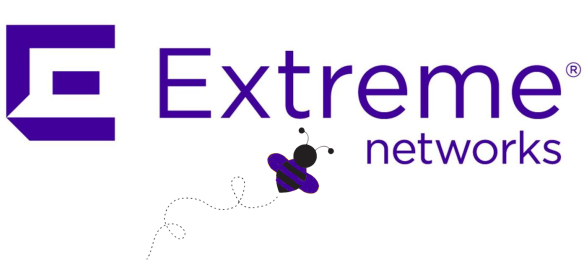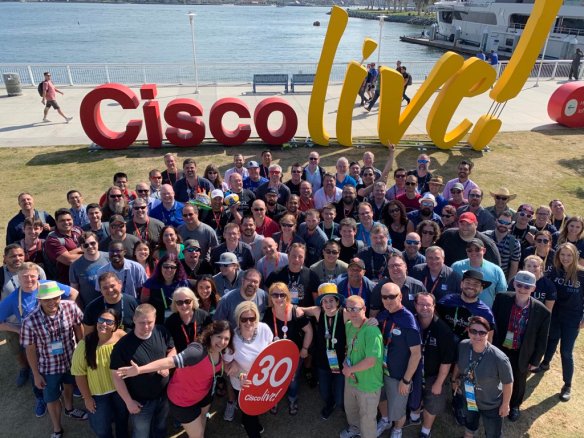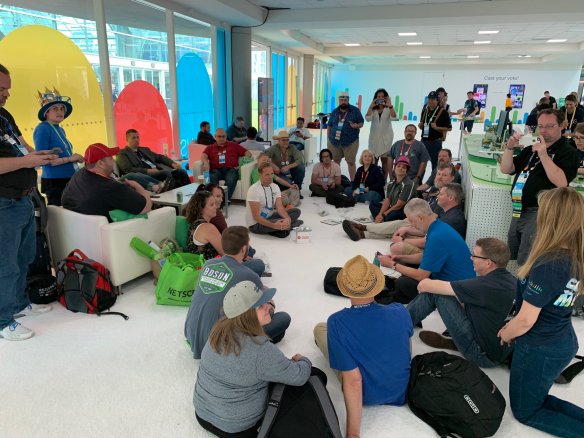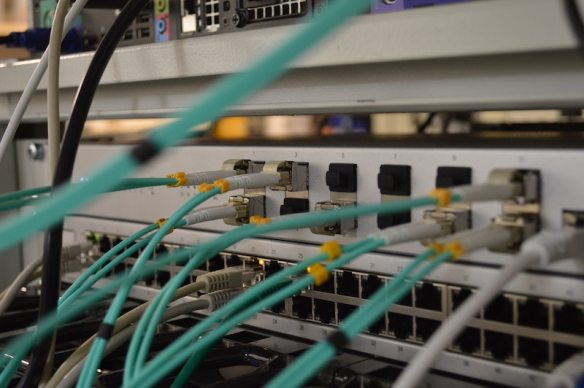What Happens When The Internet Breaks?

It’s a crazy idea to think that a network built to be completely decentralized and resilient can be so easily knocked offline in a matter of minutes. But that basically happened twice in the past couple of weeks. CloudFlare is a service provide that offers to sit in front of your website and provide all kinds of important services. They can prevent smaller sites from being knocked offline by an influx of traffic. They can provide security and DNS services for you. They’re quickly becoming an indispensable part of the way the Internet functions. And what happens when we all start to rely on one service too much?
Bad BGP Behavior
The first outage on June 24, 2019 wasn’t the fault of CloudFlare. A small service provider in Pennsylvania decided to use a BGP Optimizer from Noction to do some route optimization inside their autonomous system (AS). That in and of itself shouldn’t have caused a problem. At least, not until someone leaked those routes to the greater internet.
It was a comedy of errors. The provider in question announced their more specific routes to an upstream customer, who in turn announced them to Verizon. After that all bets are Continue reading
Extremely Hive Minded

I must admit that I was wrong. After almost six years, I was mistake about who would end up buying Aerohive. You may recall back in 2013 I made a prediction that Aerohive would end up being bought by Dell. I recall it frequently because quite a few people still point out that post and wonder what if it’s happened yet.
Alas, June 26, 2019 is the date when I was finally proven wrong when Extreme Networks announced plans to purchase Aerohive for $4.45/share, which equates to around $272 million paid, which will be adjust for some cash on hand. Aerohive is the latest addition to the Extreme portfolio, which now includes pieces of Brocade, Avaya, Enterasys, and Motorola/Zebra.
Why did Extreme buy Aerohive? I know that several people in the industry told me they called this months ago, but that doesn’t explain the reasoning behind spending almost $300 million right before the end of the fiscal year. What was the draw that have Extreme buzzing about this particular company?
Flying Through The Clouds
The most apparent answer is HiveManager. Why? Because it’s really the only thing unique to Aerohive that Extreme really didn’t have already. Aerohive’s APs Continue reading
Cisco Live 2019 – Rededicating Community

The 2019 Cisco Live Sign Photo
Another Cisco Live is in the books for me. I was a bit shocked to realize this was my 14th event in a row. I’ve been going to Cisco Live half of the time it’s been around! This year was back in San Diego, which has good and bad points. I’d like to discuss a few of them there and get the thoughts of the community.
Good: The Social Media Hub Has Been Freed! – After last year’s issues with the Social Media Hub being locked behind the World of Solutions, someone at Cisco woke up and realized that social people don’t keep the same hours as the show floor people. So, the Hub was located in a breezeway between the Sails Pavilion and the rest of the convention center. And it was great. People congregated. Couches were used. Discussions were had. And the community was able to come together again. Not during the hours when it was convenient. But a long time. This picture of the big meeting on Thursday just solidifies in my mind why the Social Media Hub has to be in a common area:

You don’t get this kind of Continue reading
The CCIE Times Are A Changing

Today is the day that the CCIE changes. A little, at least. The news hit just a little while ago that there are some changes to the way the CCIE certification and recertification process happens. Some of these are positive. Some of these are going to cause some insightful discussion. Let’s take a quick look at what’s changing and how it affects you. Note that these changes are not taking effect until February 24, 2020, which is in about 8 months.
Starting Your Engines
The first big change comes from the test that you take to get yourself ready for the lab. Historically, this has been a CCIE written exam. It’s a test of knowledge designed to make sure you’re ready to take the big lab. It’s also the test that has been used to recertify your CCIE status.
With the new change on Feb. 24th, the old CCIE written will go away. The test that is going to be used to qualify candidates to take the CCIE lab exam is the Core Technology exam from the CCNP track. The Core Technology exam in each CCNP track serves a dual purpose in the new Cisco certification program. If you’re Continue reading
Home on the Palo Alto Networks Cyber Range

You’ve probably heard many horror stories by now about the crazy interviews that companies in Silicon Valley put you though. Sure, some of the questions are downright silly. How would I know how to weigh the moon? But the most insidious are the ones designed to look like skills tests. You may have to spend an hour optimizing a bubble sort or writing some crazy code that honestly won’t have much impact on the outcome of what you’ll be doing for the company.
Practical skills tests have always been the joy and the bane of people the world over. Many disciplines require you to have a practical examination before you can be certified. Doctors are one. The Cisco CCIE is probably the most well-known in IT. But what is the test really quizzing you on? Most people will admit that the CCIE is an imperfect representation of a network at best. It’s a test designed to get people to think about networks in different ways. But what about other disciplines? What about the ones where time is even more of the essence than it was in CCIE lab?
Red Team Go!
I was at Palo Alto Networks Ignite19 this past Continue reading
The Good, The Bad, and The Questionable: Acquisition Activities

Sometimes I read the headlines when a company gets acquired and think to myself, “Wow, that was a great move!” Other times I can’t really speak after reading because I’m shaking my head too much about what I see to really make any kind of judgement. With that being said, I think it’s time to look at three recent acquisitions through the lens of everyone’s favorite spaghetti western.
The Good – Palo Alto Buys Twistlock: This one was kind of a no-brainer to me. If you want to stay relevant in the infrastructure security space you’re going to need to have some kind of visibility into containers. If you want to stay solvent after The Cloud destroys all infrastructure spending forevermore, you’re going to need to learn how to look into containers. And when you’re ready and waiting for the collapse of the cloud, containers are probably still going to be relevant.
Joking aside, this is a great move for Palo Alto. They’re getting a lot of container talent and can start looking at all kinds of ways to integrate that into their solution sets. It lets people in the organization justify the spend they have for security Continue reading
Will Spectrum Hunger Kill Weather Forecasting?

If you are a fan of the work we do each week with our Gestalt IT Rundown on Facebook, you probably saw a story in this week’s episode about the race for 5G spectrum causing some potential problems with weather forecasting. I didn’t have the time to dig into the details behind the story on that episode, so I wanted to take a few minutes and explain why it’s such a big deal.
First, you have to know that 5G (and many other) speeds are entirely dependent upon the amount of spectrum they can use to communicate. The more spectrum available to them, the more channels they have available to communicate. Which increases the speed they can exchange information and reduces the amount of interference between devices. Sounds simple right?
Except mobile devices aren’t the only things that are using the spectrum. We have all kinds of other devices out there that use radio waves to communicate. We’ve known for several years that there are a lot of devices in the 5 GHz spectrum used by 802.11 that interfere with wireless devices. Things like ISM radios for industrial and medical applications or government radar systems. The government has instituted Continue reading
You Don’t Want To Be A Rock Star

When I say “rock star”, you probably have all kinds of images that pop up in your head. Private planes, penthouse suites, grand stages, and wheelbarrows full of money are probably on that list somewhere. Maybe you’re a purist and you think of someone dedicated to the craft of entertaining the masses and trying to claw their way to fame one note at a time. But I’m also sure in both of those cases you also think about the negative aspects of being a rock star. Like ego. And lack of humility. I want to touch on some of that as it pertains to our jobs and our involvement in the community.
Great Like Elvis. Without The Tassels.
The rock star mentality at work is easy to come by. Perhaps you’re very good at what you do. You may even be the best at your company or even at the collection of companies that are your competitors. You’re the best senior architect there is. You know the products and the protocols and you can implement a complex project with your eyes closed. That’s how people start looking at you. Larger than life. The best. One of a kind.
And that Continue reading
IT And The Exception Mentality

If you work in IT, you probably have a lot in common with other IT people. You work long hours. You have the attitude that every problem can be fixed. You understand technology well enough to know how processes and systems work. It’s fairly common in our line of work because the best IT people tend to think logically and want to solve issues. But there’s something else that I see a lot in IT people. We tend to focus on the exceptions to the rules.
Odd Thing Out
A perfectly good example of this is automation. We’ve slowly been building toward a future when software and scripting does the menial work of network administration and engineering. We’ve invested dollars and hours into making interfaces into systems that allow us to repeat tasks over and over again without intervention. We see it in other areas, like paperwork processing and auto manufacturing. There are those in IT, especially in networking, that resist that change.
If you pin them down on it, sometimes the answers are cut and dried. Loss of job, immaturity of software, and even unfamiliarity with programming are common replies. However, I’ve also heard a more common response growing Continue reading
Cisco’s Catalyst for Change

You’ve probably heard by now of the big launch of Cisco’s new 802.11ax (neé Wi-Fi 6) portfolio of devices. Cisco did a special roundtable with a group of influencers from the community called Just The Tech. Here’s a video from that event covering the APs that were released, the 9120:
Fred always does a great job of explaining the technical bits behind the APs. But one thing that caught my eye here is the name of the AP – Catalyst. Cisco has been using Aironet for their AP line since they purchased Aironet Wireless Communications back in 1999. The name was practically synonymous with wireless technologies for many people in the industry that worked exclusively with Cisco technologies.
So, is the name change something we should be concerned about?
A Rose Is a Rose Is An AP
Cisco moving toward a unified naming convention for their edge solutions makes a lot of sense. Ten years ago, wireless was still primarily 802.11g-based with 802.11n still a few months away from being proposed and ratified. Connectivity hadn’t quite yet reached the ubiquitous levels of wireless that we see today. The iPhone was only about to be on its third Continue reading
Increasing Entropy with Crypto4A

Have you ever thought about the increasing disorder in your life? Sure, it may seem like things are constantly getting crazier every time you turn around, but did you know that entropy is always increasing in the universe? It’s a Law of Thermodynamics!
The idea that organized systems want to fall into disorder isn’t too strange when you think about it. Maintaining order takes a lot of effort and disorder is pretty easy to accomplish by just giving up. Anyone with a teenager knows that the amount of disorder that can be accomplished in a bedroom is pretty impressive.
One place where we don’t actually see a lot of disorder is in the computing realm. Computers are based on the idea that there is order and rationality in everything that we do. This is so prevalent that finding a way to be random is actually pretty hard. Computer programmers have tried a number of ways to come up with random number generators that take a variety of inputs into the formula and come up with something that looks sufficiently random. For most people just wanting the system to guess a number between 1 and 100 it’s not too bad. But Continue reading
The Confluence of SD-WAN and Microsegmentation

If you had to pick two really hot topics in the networking space right now, you’d be hard-pressed to find two more discussed than SD-WAN and microsegmentation. SD-WAN is the former “king of the hill” in the network engineering. I can remember having more conversations about SD-WAN in the last couple of years than anything else. But as the SD-WAN market has started to consolidate and iterate, a new challenger has arrived. Microsegmentation is the word of the day.
However, I think that SD-WAN and microsegmentation are quickly heading toward a merger of ideas and solutions. There are a lot of commonalities between the two technologies that make a lot of sense running together.
SD-WAN isn’t just about packet switching and routing any longer. That’s because networking people have quickly learned that packet-by-packet processing of traffic is inefficient. All of our older network analysis devices could only see things one IP packet at a time. But the new wave of devices think in terms of flows. They can analyze a stream of packets to figure out what’s going on. And what generates those flows?
Applications.
The key to the new wave of SD-WAN technology isn’t some kind of magic method Continue reading
802.11ax Is NOT A Wireless Switch

802.11ax is fast approaching. Though not 100% ratified by the IEEE, the spec is at the point where most manufacturers and vendors are going to support what’s current as the “final” version for now. While the spec for what marketing people like to call Wi-Fi 6 is not likely to change, that doesn’t mean that the ramp up to get people to buy it is showing any signs of starting off slow. One of the biggest problems I see right now is the decision by some major AP manufacturers to call 802.11ax a “wireless switch”.
Complex Duplex
In case you had any doubts, 802.11ax is NOT a switch.1 But the answer to why that is takes some explanation. It all starts with the network. More specifically, with Ethernet.
Ethernet is a broadcast medium. Packets are launched into the network and it is hoped that the packet finds the destination. All nodes on the network listen and, if the packet isn’t destined for them they discard it. This is the nature of the broadcast. If multiple stations try to talk at once, the packets collide and no one hears anything. That’s why Ethernet developed a collision detection Continue reading
OpenConfig and Wi-Fi – The Winning Combo

Wireless isn’t easy by any stretch of the imagination. Most people fixate on the spectrum analysis part of the equation when they think about how hard wireless is. But there are many other moving parts in the whole architecture that make it difficult to manage and maintain. Not the least of which is how the devices talk to each other.
This week at Aruba Atmosphere 2019, I had the opportunity to moderate a panel of wireless and security experts for Mobility Field Day Exclusive. It was a fun discussion, as you can see from the above video. As the moderator, I didn’t really get a change to explain my thoughts on OpenConfig, but I figured now would be a great time to jump in with some color on my side of the conversation.
Yin and YANG
One of the most exciting ideas behind OpenConfig for wireless people should be the common YANG data models. This means that you can use NETCONF to have a common programming language against specific YANG models. That means no more fumbling around to remember esoteric commands. You just tell the system what you want it to do and the rest is easy.
As outlined Continue reading
Fast Friday – Aruba Atmosphere 2019
A couple of quick thoughts that I’m having ahead of Aruba Atmosphere next week in Las Vegas, NV. Tech Field Day has a lot going on and you don’t want to miss a minute of the action for sure, especially on Wednesday at 3:15pm PST. In the meantime:
- IoT is really starting to more down-market. Rather than being focused on enabling large machines with front-end devices to act as gateways we’re starting to see more and more IoT devices either come with integrated connective technology or interface with systems that do. Building control systems aren’t just for large corporations any more. You can automate an office on the cheap today. Just remember that any device that can talk can also listen. Security posture is going to be huge.
- I remember some of the discussions that we had during the heady early days of SDN and how unimpressed wireless and mobility people were when they figured out how the controllers and dumb edge devices really worked. Most wireless pros have been there and done that already. However, recently there has been a lot of movement in the OpenConfig community around wireless devices. And that really has the wireless folks excited. Because Continue reading
The Blogging Mirror

Writing isn’t always the easiest thing in the world to do. Coming up with topics is hard, but so too is making those topics into a blog post. I find myself getting briefings on a variety of subjects all the time, especially when it comes to networking. But translating those briefings into blog posts isn’t always straight forward. When I find myself stuck and ready to throw in the towel I find it easy to think about things backwards.
A World Of Pure Imagination
When people plan blog posts, they often think about things in a top-down manner. They come up with a catchy title, then an amusing anecdote to open the post. Then they hit the main idea, find a couple of supporting arguments, and then finally they write a conclusion that ties it all together. Sound like a winning formula?
Except when it isn’t. How about when the title doesn’t reflect the content of the post? Or the anecdote or lead in doesn’t quite fit with the overall tone? How about when the blog starts meandering away from the main idea halfway through with a totally separate argument? Or when the conclusion is actually the place where the Continue reading
QoS Is Dead. Long Live QoS!

Ah, good old Quality of Service. How often have we spent our time as networking professionals trying to discern the archaic texts of Szigeti to learn how to make you work? QoS is something that seemed so necessary to our networks years ago that we would spend hours upon hours trying to learn the best way to implement it for voice or bulk data traffic or some other reason. That was, until a funny thing happened. Until QoS was useless to us.
Rest In Peace and Queues
QoS didn’t die overnight. It didn’t wake up one morning without a home to go to. Instead, we slowly devalued and destroyed it over a period of years. We did it be focusing on the things that QoS was made for and then marginalizing them. Remember voice traffic?
We spent years installing voice over IP (VoIP) systems in our networks. And each of those systems needed QoS to function. We took our expertise in the arcane arts of queuing and applied it to the most finicky protocols we could find. And it worked. Our mystic knowledge made voice better! Our calls wouldn’t drop. Our packets arrived when they should. And the world was Continue reading
Silo 2: On-Premise with DevOps

I had a great time stirring up the hornet’s nest with the last post about DevOps, so I figured that I’d write another one with some updated ideas and clarifications. And maybe kick the nest a little harder this time.
Grounding the Rules
First, we need to start out with a couple of clarifications. I stated that the mantra of DevOps was “Move Fast, Break Things.” As has been rightly pointed out, this was a quote from Mark Zuckerberg about Facebook. However, as has been pointed out by quite a few people, “The use of basic principles to enable business requirements to get to production deployments with appropriate coordination among all business players, including line of business, developers, classic operations, security, networking, storage and other functional groups involved in service delivery” is a bit more of definition than motto.
What exactly is DevOps then? Well, as I have been educated, it’s a principle. It’s an idea. A premise, if you will. An ideal to strive for. So, to say that someone is on a DevOps team is wrong. There is no such thing as a classic DevOps team. DevOps is instead something that many other teams do in Continue reading
DevOps is a Silo

Silos are bad. We keep hearing how IT is too tribal and broken up into teams that only care about their swim lanes. The storage team doesn’t care about the network. The server teams don’t care about the storage team. The network team is a bunch of jerks that don’t like anyone. It’s a viscous cycle of mistrust and playground cliques.
Except for DevOps. The savior has finally arrived! DevOps is the silo-busting mentality that will allow us all to get with the program and get everything done right this time. The DevOps mentality doesn’t reinforce teams or silos. It focuses on the only pure thing left in the world – committing code. The way of the CI/CD warrior. But what if I told you that DevOps was just another silo?
Team Players
Before the pitchforks and torches come out, let’s examine why IT has been so tribal for so long. The silo mentality came about when we started getting more specialized with regards to infrastructure. Think about the original compute resources – mainframes. There weren’t any silos with mainframes because everyone pretty much had to know what they were doing with every part of the system. Everything was connected Continue reading
Atmosic and the Power of RF?

I recently talked to a company doing some very interesting things in the mobility space and I thought I’d take a stab at writing about them. Most of my mobility posts are about access points or controller software or me just complaining in general about the state of Wi-Fi 6. But this idea had me a little intrigued. And confused.
Bluetooth Moon Rising
Atmosic is a company that is focusing on low-power chips, especially for IoT applications. Most of their team came from Atheros, which you may recall powers a ton of the reference architectures used in wireless APs in many, many AP manufacturers that don’t make their own chips. Their team has the chops to make good wireless stuff one would think.
Atmosic wants to make IoT devices that use Bluetooth Low Energy (BLE). So far, this is sounding pretty good to me. I’ve seen a lot of crazy awesome ideas for BLE, like location tracking indoors or on-demand digital signage. Sure, there are some tracking issues that go along with that but it’s mostly okay. BLE is what the industry has decided to standardize on for a ton of IoT functionality.
How does Atmosic want to change things Continue reading